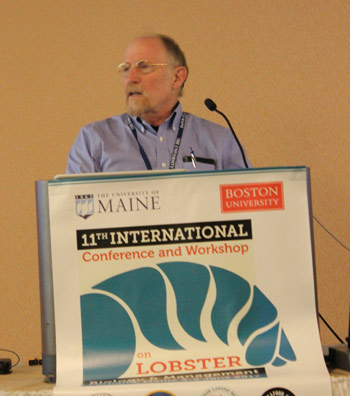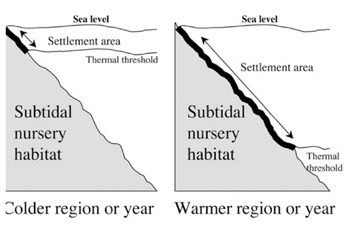Lobster Industry Grapples with Climate Change
continued from July 2017 Homepage

More than 215 attendees from 15 countries at the 11th ICWL keynote address July 7, 2017. Carl Wilson and Dave Cousens spoke, Bob Steneck, UMaine & Darling Marine Center, gave the keynote address on industry day. Fishermen’s Voice photo
midcoast Maine since he was a child, lobster fishing in the 1970s. At that time, about 20 million pounds of lobster were caught per year, on average.
“It wasn’t a real lucrative business,” Cousens said. “You had to love it to want to do it. I put myself through college lobstering in the summer.”
Through the 1980s, the water temperature in his area was never above 60 degrees. The average lobstermen hauled perhaps 30,000 pounds a year.
“Through the ‘80s, we were told by state biologists that the lobster resource was going to crash and it was a dying industry and you’d better get out now,” Cousens said.
About that time, catches weren’t that great, he said. He met lobster scientist Bob Steneck and suggested working together.
“At that point, there was a pretty big adversarial role between scientists and fishermen,” said Cousens. “They didn’t believe each other.”
In the late ‘80s, Steneck received a grant to do larval surveys.
“We didn’t have any hope for the future,” said Cousens. “We were just struggling along.” Cousens took Steneck, a diver, out on his boat.
When Steneck returned from his dives, “He said, ‘I can’t believe it. There are so many tiny lobsters on the bottom. You’re going to be okay,’” Cousens recalled.
Through the 1980s, fishing was slow, said Cousens. In the 1990s, the water temperature started to increase, and that resulted in bigger catches. As the water continued to warm, in the late 1990s, the industry took 75-80 million pounds.
“We said, ‘How far is this going to go?’” Cousens recalled.
In 2009, the fishery took about 100 million pounds.
“In 2012, the year everything went to hell, we had 120 million pounds and people almost going bankrupt because the price went to $2.30, $2.40, which wasn’t sustainable,” Cousens said. “And that’s when people said this global warming thing is serious, we’ve got to pay attention to this.”
This year, he said, shedders are again coming in early.

Bob Steneck, PhD, focused on the impact of climate change on the GOM lobster resource. Understanding these changes broadly is the challenge. Fishermen’s Voice photo
“Yesterday I had 20 pounds of shedders,” he said. “You’re not supposed to get shedders where I fish” at this time of year. “In the ‘70s and ‘80s, the old-timers told me, where I fish, you can set your clock: The shedders will come between the 17th and the 19th of July every year.” But for the past 20 years, he said, it’s been impossible to tell when the shedders will come in. “In 2012, we were catching hundreds of pounds at the end of May, and 500-600 pounds in June, which is a month and a half earlier than we should. Last year, we had 100 to 200 pounds every day in June. It wasn’t a huge volume, but it showed the biological clock of lobsters is shifting. Some are shedding in January. They’re shedding year-round now. So as a harvesters we need to embrace science in order to help us understand what’s going on. Climate change affects our living.”
Steneck was the conference’s keynote speaker. A professor at the University of Maine’s School of Marine Sciences who has done years of research on the lobster resource, he said that, over the past 20 years, the economic diversity of marine resources harvested in Maine has declined by almost 70 percent. Today, over 70 percent of the value of Maine’ s fish and seafood landings is from highly abundant lobsters, and 2016 was another record in landings and value.
Inflation-corrected income from lobsters in Maine has steadily increased by nearly 400 percent since 1985. Many fisheries managers, policymakers, and fishermen view the fishery as a success. However, monoculture increases the social and ecological risks should anything happen to the lobster.
Sustainability in a shifting environment is a complex question, said Steneck.
Often, he said, the notion of sustainability is simplified to an equation—resource production has to be greater than harvest.
“But that’s only a small part of it,” Steneck said. “One thing we’re thinking about more here in Maine is, do the benefits exceed the costs and risks.”
Sustaining Maine’ maritime heritage falls solidly on the shoulders of the lobster, said Steneck.
“If we look internationally, we find that fisheries have rarely been sustainable,” Steneck said. “Often its just a positive spin for most fisheries to talk about sustainability. But really, Maine lobster is a very different story. One way to think about this is, is this America’s most sustainably fishery or is it an accident waiting to happen?”
The lobster industry assumes rising costs and risk, given the uncertainty of climate change, Steneck said.
But the story is more complicated, he said. Lobster was thought to be on the verge of commercial extinction a hundred years ago, and yet the resource is doing better than ever today.
“I think it’s fair to say that there’s not another fishery in the world that’s been targeted for 150 years and is doing better today than ever before,” Steneck said.
Steneck pointed to three primary drivers of the resource. One has to do with altered food webs and a predator-free environment.
“Arguably, it’s a domesticated ecosystem,” he said.
Up until recent decades, the Maine coast was a predator-dominated environment, with plentiful large cod and haddock to be found. Cod is known as the lobster’s most destructive enemy. But since 2000, the coast has been largely free of predators, altering the ecosystem in favor of lobsters.
Another driver is the industry’s conservation ethic.
“This is a remarkable one for the lobstermen, and it has had consequences in terms of increasing reproductive potential,” he said. “The conservation ethic is amazing. Self-policing is a big part of how the conservation ethic evolved.”
The third driver is climate change, which is causing the lobster’s habitat to fundamentally change. That’s seen in numerous studies, he said. One study shows that catch per unit of effort has steadily increased, “even skyrocketing in recent years,” he said. “So lobster populations are clearly outpacing the rates of depletion. This is pretty remarkable.”
Other studies show that lobsters are moving from west to east and north, said Steneck. Sampling he performed in 1989 at 91 sites along the coast showed the highest abundance of lobsters in western Maine, then falling off as he moved east. Within a decade, using the same methods and locations, he found the lobster population had shifted.
“Climate charge is a big driver,” he said. “All the lobstermen I talk to are following water temperature and following the molt. This is something that’s a big part of lobstering. And it’s a big driver of change.”
Other studies looking at larval settlement, which is triggered by water temperature, also show a thermal “sweet spot” that’s moving west to east.
“That’s important, because these are good times—but they might not last forever,” he said.
Given the lobster’s success story, it might be hard to find a downside, Steneck said. But as the industry invests more heavily in the fishery, they could be increasing their risk in case there’s ever a downturn of the resource. The lobster resource started to take off just about the time that diversity among other species plummeted.
“That moves toward monoculture,” he said. At one time, looking at Maine’s coastal fisheries and the proportion of what species were caught, lobster was the only invertebrate in the top 10, and it wasn’t at the top.

As water temperatures in the GOM have warmed the depth of the settlement area has deepened. The original 32-foot depth where the temperature is cold enough to cause lobster larvae to go no deeper is now about five times deeper. It is believed that current low settlement numbers may be a result of this larger, less densely populated comfort zone for lobster larvae. Bob Steineck graphic
“Look at that today and it’s an entirely different story. If anything happens to that lobster, there’s no safety net,” he said. “We have lobster traps as far as the eye can see. The question is, is this a socio-economic time bomb?...What’s interesting is that almost all of the lobstermen I’ve talked with were not surprised to hear this. So it’s not hard to see the danger of putting all of your economic future into a single stock.”
What’s difficult in Maine, he said, is that people who have been in the lobster fishery for years are now stuck in “silos”—they don’t have a history of fishing for other species, and have no capacity to go from one fishery to another.
“So if we’re going to move to ecosystem-based management, we actually have real barriers to doing that, at least at the harvesting level,” Steneck said. “You have to be conscious of the increased costs and risks. Is it a good idea to be dependent on a single species?”
Trends in the lobster fishery are also tied to trends in the herring fishery, he said. Herring is the second most valuable species in Maine, although it is worth only 2.6 percent of Maine’ s commercial landings.
“In terms of weight, herring was always the biggest tonnage harvested on the coast of Maine, until recently,” he said. “What happened is that the lobster tonnage is exceeding herring. We’re now importing bait from as far away as New Zealand. The value of herring has been skyrocketing and it’s increased significantly the cost of fishing. So my concern is that we are fishing hard but we’re not necessarily fishing smart.”
Bait also feeds into the domesticated ecosystem idea, he said.
“First, you take always all the predators. Then you feed what you’re trying to harvest,” he said. “That’s domestication.”
As the water continues to warm, fishermen must consider that the sweet spot might leave Maine all together, he said.
“This problem of being an economic time bomb could be real,” he said. “If the lobster populations crashed in Maine, how long would it be before coastal villages would be lost to gentrification? And even if the lobster stock recovers, there’s little chance you’d be able to get back in. The social systems flip and lock into an alternative state.”
The future of lobster looks interesting and confusing at the same time, he said. While larval settlement studies show a decline, other studies show a strong presence of adult lobsters.
“The indications suggest we’re actually still doing pretty well for the time being,” he said. “The increase of lobster has been big news throughout the United States.”
In fact, he said, any problems with the fishery have been economic, such as the 2012 price crash, not biological.
“Very few fisheries can say that,” he said. “But it’s a serious problem and a tough one, too. We need to diversify our portfolio, and that’s not going to be easy.”
But it might be possible to diversify fisheries with the increasing presence of species that are migrating north, such as red hake, black sea bass, and squid, he said.
“I think we’ll have to reinvent fisheries management so fishermen can become better stewards of their fishing grounds and see what we can do to get back to multi-species fishing,” he said. “The old-timers remember when they used to go for a number of different species, depending on the season….We have to be thinking about the future. We have to think about change. The challenge will be to find ways of locally managing this dynamic ecosystem. It will have to be done by everybody.”
